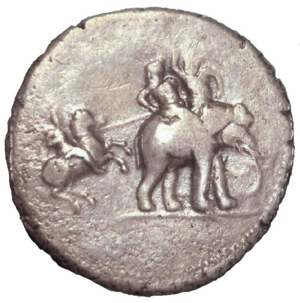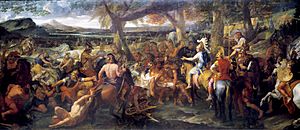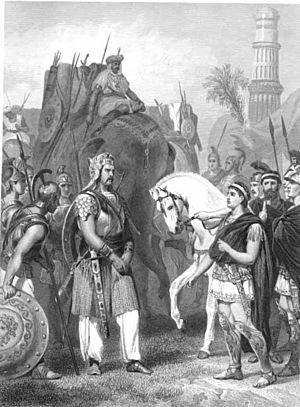Porus facts for kids
Quick facts for kids Porus |
|
|---|---|

King Porus (on elephant) fighting Alexander the Great, on a "victory coin" of Alexander (made around 324–322 BC)
|
|
| Reign | before 326 – c. 317 BC |
| Born | Punjab |
| Died | c. 321 – c. 315 BC Punjab |
Porus (also spelled Poros) was an ancient Indian king. His kingdom was in the Punjab region of the Indian subcontinent, between the Jhelum River and Chenab River. We only know about him from Greek writings.
Porus was known as a brave warrior. He fought against Alexander the Great in a famous battle called the Battle of the Hydaspes in 326 BC. Porus lost the battle, but Alexander was so impressed by his courage that he let Porus keep his kingdom. Alexander even gave Porus more land to rule. Porus likely died sometime between 321 and 315 BC.
Contents
Who Was Porus?
Historians have different ideas about who Porus was.
Purus Tribe
Some historians, like Michael Witzel, think Porus was a king of the Pūrus tribe. This tribe was important in Punjab a long time ago.
Sourasenis Tribe
Ancient Greek writers like Megasthenes wrote about an Indian tribe called Sourasenoi. They worshipped a god they called "Herakles." This tribe lived near the cities of Mathura and the Yamuna River. Greeks often compared foreign gods to their own. Many scholars think "Herakles" here means "Hari-Krishna."
One writer, Quintus Curtius Rufus, said Porus's soldiers carried a banner of "Herakles" when they faced Alexander. Because of this, some historians believe Porus might have been from the Shurasena tribe. However, this idea is not fully proven.
Porus's Kingdom
Porus ruled the land between the Jhelum and Chenab rivers. It was a large area with almost 300 cities. Porus did not get along with the nearby kingdom of Taxila. He had even killed their previous ruler, Ambhiraj.
Porus also had a nephew, who was also called Porus by the Greeks. This nephew ruled a different area between the Ravi and Chenab rivers.
Before the Big Battle
When Alexander the Great's army came to India, they crossed the Indus River. The ruler of Taxila, Omphis (Ambhi), welcomed Alexander. Omphis wanted Alexander's help to defeat Porus and another king named Abisares.
Abisares agreed to surrender to Alexander, but Porus refused. This led Alexander to prepare for a fight on the banks of the Jhelum River. This was the start of the Battle of the Hydaspes in 326 BC. The exact place of the battle is still unknown.
Battle of the Hydaspes
Alexander used the same boats he had used before to cross the Jhelum River. He sent small groups to try and cross the river often. This was to trick Porus's army.
Alexander decided to cross the river with a main attack force. He left many soldiers behind to follow later. Other groups of soldiers were spread along the river to distract Porus. This plan worked. Alexander's forces crossed the Jhelum River on a stormy night, just before morning. Porus's son saw them and attacked with horsemen. But Alexander's cavalry (soldiers on horseback) pushed them back.
When Porus learned Alexander had crossed, he focused on fighting those who had already crossed. He set up his army in the plains. He placed his foot soldiers with elephants in the front. His cavalry and chariots were on the sides. Alexander attacked Porus's left side with his cavalry. This made Porus move soldiers from his right side to help.
However, Alexander's other cavalry units attacked these moving soldiers from behind. This caused confusion in Porus's army. Porus's cavalry had to hide among their own foot soldiers.
This led to a huge battle. Porus's plans did not work well. His cavalry attacks were stopped. The elephant riders were killed. The elephants were pushed back into Porus's own lines, causing chaos. Alexander's cavalry kept attacking, making Porus's army disorganized. Soon, Porus's army was surrounded. Most of his elephants were captured, and his cavalry was destroyed.
Porus still refused to give up. He stayed on his elephant until he was wounded. His army was defeated. Some foot soldiers tried to escape, but Alexander's general, Craterus, chased them down.
Battle Outcome
The battle was a clear victory for the Greeks. Alexander held games to celebrate his win. He also built two cities to remember the battle. One was Nicaea, where he won. The other was Bucephalous, named after his horse, Bucephalus. Coins were even made showing Alexander on horseback, attacking Indians on an elephant.
After the Battle
Even though Porus lost, Alexander was very impressed by him. Alexander decided not to remove Porus from his throne. Instead, he gave Porus back his kingdom and even added more land to it. Alexander's forces took over the lands of Glausaes, a ruler to the northeast of Porus's kingdom. Alexander also helped Porus and Omphis (the ruler of Taxila) become friends.
Later, Porus and Alexander worked together. They attacked a territory east of the Chenab River. This land was ruled by an enemy cousin of Porus. Alexander's army took over these lands. They faced strong resistance at a walled city called Sangala. Porus joined Alexander with his elephants, and they attacked the city. After Sangala and other cities were destroyed, Porus was allowed to put his own soldiers there.
After this, Alexander wanted to cross the Beas River and go further into India. But it was monsoon season, and his tired soldiers refused to go on. Alexander had to give up his plans and turn back. Porus became the main ruler of all the land east of the Jhelum River. Unlike other rulers, he did not have a European governor sharing his power.
Porus's Death
Alexander the Great died in 323 BC. After Alexander's death, his empire was split among his generals. A general named Perdiccas became the regent (a ruler for a young king). After Perdiccas died in 321 BC, Antipater became the new regent.
According to a historian named Diodorus, Antipater confirmed that Porus could rule his lands along the Indus River. However, another general named Eudemus, who was Alexander's governor in Punjab, sadly killed Porus.
See also
 In Spanish: Poros (rey) para niños
In Spanish: Poros (rey) para niños



